Related Research Articles

The Duchy of Mecklenburg-Schwerin was a duchy in northern Germany created in 1701, when Frederick William and Adolphus Frederick II divided the Duchy of Mecklenburg between Schwerin and Strelitz. Ruled by the successors of the Nikloting House of Mecklenburg, Mecklenburg-Schwerin remained a state of the Holy Roman Empire along the Baltic Sea littoral between Holstein-Glückstadt and the Duchy of Pomerania.

Polabian Slavs is a collective term applied to a number of Lechitic tribes who lived scattered along the Elbe river in what is today eastern Germany. The approximate territory stretched from the Baltic Sea in the north, the Saale and the Limes Saxoniae in the west, the Ore Mountains and the Western Sudetes in the south, and Poland in the east. They have also been known as Elbe Slavs or Wends. Their name derives from the Slavic po, meaning "by/next to/along", and the Slavic name for the Elbe.
The Diocese of Ratzeburg is a former diocese of the Catholic Church. It was erected from the Diocese of Oldenburg c. 1050 and was suppressed in 1554. The diocese was originally a suffragan of the Archdiocese of Hamburg; in 1072 it became a suffragan of the merged entity — the "Archdiocese of Hamburg and the Diocese of Bremen". The territory of the diocese was located in what is today the states of Schleswig-Holstein and Mecklenburg-Vorpommern in Germany. The cathedral church of the diocese — dedicated to Ss. Mary and John — is still extant in the city of Ratzeburg. Following its suppression as part of the Protestant Reformation, the remaining Catholic adherents were only represented by the Apostolic Vicariate of Northern Germany. The whole territory of the diocese is today included in the Roman Catholic Archdiocese of Hamburg.
Berno was a medieval male name and could refer to:

Borwin, Duke of Mecklenburg has been the head of the House of Mecklenburg-Strelitz since 1996 and of the entire House of Mecklenburg since 2001. The death of Friedrich Franz, Hereditary Grand Duke of Mecklenburg-Schwerin – his godfather – the last male member of the House of Mecklenburg-Schwerin on 31 July 2001 made Strelitz the only remaining line of the House of Mecklenburg, which ruled in Mecklenburg until 1918.
The Wagri, Wagiri, or Wagrians were a tribe of Polabian Slavs inhabiting Wagria, or eastern Holstein in northern Germany, from the ninth to twelfth centuries. They were a constituent tribe of the Obodrite confederacy.

Niklot or Nyklot was a chief or prince of the Slavic Obotrites and an ancestor of the House of Mecklenburg. He became chief of the Obotrite confederacy, including the Kissini and the Circipani, between the years 1130 and 1131. He remained in this position until his death in 1160. At the same time he was Lord of Schwerin, Quetzin and Malchow. For nearly 30 years he resisted Saxon princes, especially Henry the Lion during the Wendish Crusade.
Pribislav was an Obotrite prince and the first Prince of Mecklenburg (1167–1178).
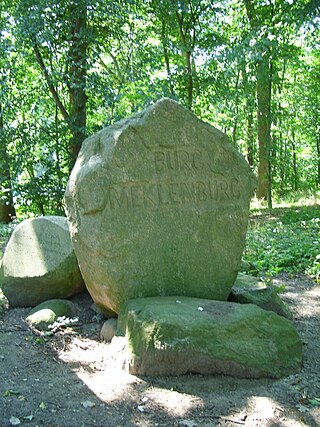
Mecklenburg Castle was a medieval castle and a residential capital of the Nakonid and Nikloting dynasties of the Obotrites. It was located just south of the modern village Dorf Mecklenburg, seven kilometres south of the Bay of Wismar in Mecklenburg-Vorpommern, Germany. The only remnants of the ruined castle are parts of an earthen wall. Some scholars have associated Mecklenburg with the medieval trading emporium Reric.
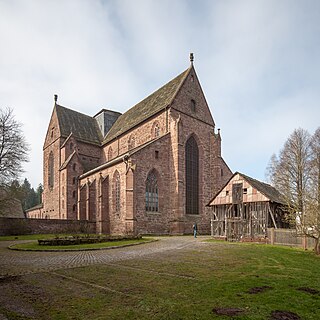
Amelungsborn Abbey, also Amelunxborn Abbey, is a Lutheran monastery in Germany. It is located near Negenborn and Stadtoldendorf, in the Landkreis of Holzminden in the Weserbergland. It was the second oldest Cistercian foundation in Lower Saxony, Germany, after Walkenried Abbey. It survived the Reformation by becoming Lutheran, and with Loccum Abbey, also previously Cistercian, is one of the only two Lutheran monasteries in Germany with an uninterrupted tradition. The abbey church, St. Mary's, is also the parish church of the abbey's former estate villages Negenborn and Holenberg.
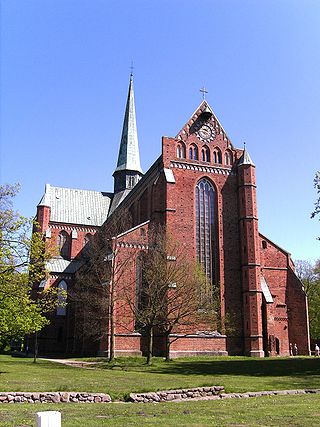
Doberan Abbey is a former Cistercian monastery in Bad Doberan, Mecklenburg-Vorpommern, Germany. The Brick Gothic church continues in use as Doberan Minster.
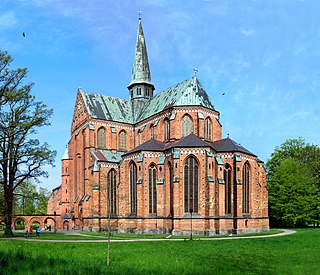
The Doberan Minster is the main Lutheran Church of Bad Doberan in Mecklenburg, Germany. Close to the Baltic Sea and the Hanseatic city of Rostock, it is the most important religious heritage of the European Route of Brick Gothic. It is the remaining part of the Ex-Cistercian Doberan Abbey, dedicated in 1368. The first abbey in Mecklenburg, founded in 1171, which was also used as the burial site for the regional rulers, became important both politically and historically.

The Principality of Rügen was a Danish principality, formerly a duchy, consisting of the island of Rügen and the adjacent mainland from 1168 until 1325. It was governed by a local dynasty of princes of the Wizlawiden dynasty. For at least part of this period, Rügen was subject to the Holy Roman Empire.

Siegfried of Anhalt was born as the third son of Sophie of Winzenburg and her husband Albert the Bear, then Count of Anhalt, of the House of Ascania. In 1168 he was elected Archbishop of Bremen. Afterward he became Prince-Bishop of Brandenburg (1173–1179) as Siegfried I. In 1179 he succeeded in getting it upgraded to a Prince-Archbishopric of imperial immediacy in 1180, thus becoming Prince-Archbishop of Bremen. He was a strong advocate of Ascanian clan interests.

In the Slavic revolt of 983, Polabian Slavs, Wends, Lutici and Obotrite tribes, that lived east of the Elbe River in modern north-east Germany overthrew an assumed Ottonian rule over the Slavic lands and rejected Christianization under Emperor Otto I.
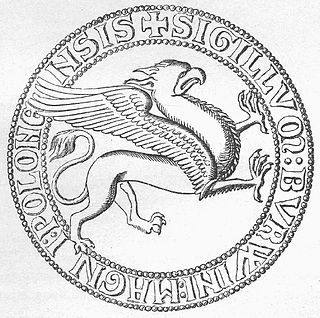
Henry Borwin I, Lord of Mecklenburg, was the ruling Lord of Mecklenburg from 1178 until his death. Sometimes a Latinized version of his name is used ; the form "Buruwe" is also found, as are "Henricus Buruwi", "Heinricus Buriwoi", and "Hinricus Burwy".

The Lordship of Parchim-Richenberg was a short-lived state of the Holy Roman Empire which existed during the 13th century. It arose from the first partition of Mecklenburg after the death of Henry Borwin II, Lord of Mecklenburg in 1226. Initially it was named after its capital Parchim. Later, following the transferral of the seat to Richenberg, the name shifted to Richenberg. The Lordship comprised the lands of Parchim, the rural area of Ture and the later Vogteis of Plau, Goldberg, Sternberg and finally Richenberg. It was the shortest-lived of the four partitioned principalities of Mecklenburg.
During its history, the state of Mecklenburg has been repeatedly partitioned into various successor states. Modern historians distinguish three main Partitions of Mecklenburg:
References
- F. Wigger: Berno, der erste Bischof von Schwerin, In: Jahrbücher de Vereins für mecklenburgische Geschichte 28, 1863, 3 ff. (in German)
- Franz Winter: Die Cisterzienser des nordöstlichen Deutschlands I, 1868, 82 ff (in German)
- Karl Schmaltz: Kirchengeschichte Mecklenburgs I, 1935 (in German)
- Karl Jordan: Die Bistumsgründungen Heinrichs des Löwen – Untersuchungen zur Geschichte der ostdeutschen Kolonisation, 1939 (in German)
- Joachim Wächter: Das Fürstentum Rügen – Ein Überblick. In Beiträge zur Geschichte Vorpommerns: die Demminer Kolloquien 1985–1994. Thomas Helms Verlag, Schwerin 1997, ISBN 3-931185-11-7. (in German)